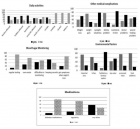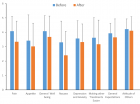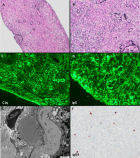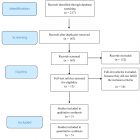Abstract
Review Article
Utilizing Pulsed Electromagnetic Field (PEMF) Therapy (Diapulse®) for Drug-Free Pain Management to Eliminate Reliance on Opioids for Non-Malignant Chronic Pain: A literature Review and Proposal for Pilot Study
Thomas A Sharon*
Published: 17 June, 2019 | Volume 3 - Issue 1 | Pages: 027-34
The Federal and State governments have declared the presence of an opioid addiction pandemic in the United States claiming the lives of more than 55,000 in 2015 (Rudd RA, Seth P, David F and Scholl L. 2016). The pharmaceutical manufacturers of the numerous FDA-approved opioid drugs are raking in more than $5 billion per year with about 2 million chronic pain sufferers addicted. The irony of this narcotic use and abuse conundrum is the existence of evidence-based technology for drug-free pain management which is not covered for reimbursement among public and private third-party payers. Therefore, this paper is presented to propose a pilot study to demonstrate the efficacy of resolving the chronic inflammation, edema and ischemia that causes non-malignant chronic pain with PEMF therapy, a non-invasive, non-thermal radio transmission of electrical impulses, thereby invalidating the legitimacy of prescribing opioid analgesics in such cases.
Read Full Article HTML DOI: 10.29328/journal.cjncp.1001013 Cite this Article Read Full Article PDF
References
- Lyapustina T, Alexander CG. The prescription opioid addiction and abuse epidemic: how it happened and what we can do about it. The Pharmaceutical Journal. 2015; 11: 1-9. Ref.: http://bit.ly/2X7YzFv
- Van Zee A. The Promotion and Marketing of OxyContin: Commercial Triumph, Public Health Tragedy. Am J Public Health. 2009; 99: 221-227. Ref.: http://bit.ly/2XFXWjn
- Rudd RA, Seth P, David F, Scholl L. Increases in Drug and Opioid-Involved Overdose Deaths — United States, 2010–2015. Morbidity and Mortality Weekly Report US Department of Health and Human Services/Centers for Disease Control and Prevention. 2016; 65: 1445-1452. Ref.: http://bit.ly/2XbCypc
- Gostin LO, Hodge JG, Noe SA. Reframing the Opioid Epidemic as a National Emergency. JAMA. 2007; 318: 1539-1540. Ref.: http://bit.ly/2KjaHxo
- Harper WL, Schmidt WK, Kubat NJ, Isenberg RA. An open-label pilot study of pulsed electromagnetic field therapy inthe treatment of failed back surgery syndrome pain. Int Med Case Rep J. 2015; 8: 13-22. Ref.: http://bit.ly/2RfxJ8L
- Reddy RS. Effect of pulsed electromagnetic field therapy on pain, pressure pain threshold, and pain-free grip strength in participants with lateral epicondylitis. Saudi J Sports Med. 2017; 7: 93-96. Ref.: http://bit.ly/2wVa30g
- Rohde CH, Taylor EM, Alonso A, Ascherman JA, Hardy KL. et al. Pulsed Electromagnetic Fields Reduce Postoperative Interleukin – 1β, Pain, and Inflammation: A Double-Blind, Placebo-Controlled Study in TRAM Flap Breast Reconstruction Patients. Plast Reconstr Surg. 2015; 135: 808e-817e. Ref.: http://bit.ly/2Zn8rsd
- Graak V, Chaudhary S, Bal BS, Sandhu JS. Evaluation of the efficacy of pulsed electromagnetic field in the management of patients with diabetic polyneuropathy. Int J Diabetes Dev Ctries. 2009; 29: 56-61. Ref.: http://bit.ly/2Xcs1tH
- Bagnato GL, Miceli G, Marino N, Sciortino D, Bagnato GF. Pulsed electromagnetic fields in knee osteoarthritis: adouble blind, placebo-controlled, randomized clinicaltrial. Rheumatology. Rheumatology (Oxford) 2015; 55: 755-762. Ref.: http://bit.ly/2Fbmj17
- Sharon TA. An Investigation of the Effects of Pulsed Electromagnetic Field Therapy on Plantar Skin Blood Perfusion in People with Diabetes Mellitus Type 2: A Pilot Study. 2015; 3732465. Ref.: http://bit.ly/2WHVmx1
- Schneiderhan J, Clauw D, Schwenk TL. Primary Care of Patients with Chronic Pain. JAMA. 2017; 317: 2367-2368. Ref.: http://bit.ly/2IfsrHF
Figures:

Figure 1
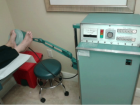
Figure 2
Similar Articles
-
A Multidisciplinary Approach to the Assessment and Management of Pre-school Age Neuro-developmental Disorders: A Local ExperienceMichael O Ogundele*. A Multidisciplinary Approach to the Assessment and Management of Pre-school Age Neuro-developmental Disorders: A Local Experience. . 2017 doi: 10.29328/journal.hjncp.1001001; 1: 001-012
-
The Outcome of an ADHD Parenting Group Training Programme (APEG) In the Peterborough Neurodevelopmental Service (NDS)Hani Ayyash*,Michael O Ogundele,Ruth Wisbey,Emma Weisblatt,Lorraine Cuff,Venkat Reddy. The Outcome of an ADHD Parenting Group Training Programme (APEG) In the Peterborough Neurodevelopmental Service (NDS). . 2017 doi: 10.29328/journal.hjncp.1001002; 1: 013-019
-
Dealing with Depression in Family CaregiversWai Hing HUI-CHOI*. Dealing with Depression in Family Caregivers. . 2017 doi: 10.29328/journal.hjncp.1001003; 1: 020-030
-
Caring Difficulties of Parents’ Towards Children with Cerebral PalsyMelike Ertem*. Caring Difficulties of Parents’ Towards Children with Cerebral Palsy. . 2017 doi: 10.29328/journal.hjncp.1001004; 1: 031-033
-
Behavioral transformation through inner conflict resolution: A new Nursing TheoryThomas A Sharon*. Behavioral transformation through inner conflict resolution: A new Nursing Theory. . 2018 doi: 10.29328/journal.cjncp.1001005; 2: 001-007
-
A Case-Study of the Anatomy of a Miscommunication: Why colleagues as patients develop complications?Colin Pritchard*,Jeremy Latham. A Case-Study of the Anatomy of a Miscommunication: Why colleagues as patients develop complications?. . 2018 doi: 10.29328/journal.cjncp.1001006; 2: 008-011
-
Women’s Mental Health and Mental retardationSharadha Ramesh*. Women’s Mental Health and Mental retardation. . 2018 doi: 10.29328/journal.cjncp.1001007; 2: 012-017
-
Effect of spiritual health (Sound Heart) on the other dimensions of health at different levels of preventionMinoo Asadzandi*. Effect of spiritual health (Sound Heart) on the other dimensions of health at different levels of prevention. . 2018 doi: 10.29328/journal.cjncp.1001008; 2: 018-024
-
Best and effective practices of wound care and healing among patients with Diabetes MellitusJefferson Garcia Guerrero*. Best and effective practices of wound care and healing among patients with Diabetes Mellitus. . 2018 doi: 10.29328/journal.cjncp.1001009; 2: 025-031
-
Knowledge, attitude, practice and associated factors towards nursing care documentation among nurses in West Gojjam Zone public hospitals, Amhara Ethiopia, 2018Atsedemariam Andualem*,Tarekegn Asmamaw,Mezinew Sintayehu,Tiliksew Liknaw,Afework Edmealem,Bekalu Bewuket,Mihretie Gedfew. Knowledge, attitude, practice and associated factors towards nursing care documentation among nurses in West Gojjam Zone public hospitals, Amhara Ethiopia, 2018. . 2019 doi: 10.29328/journal.cjncp.1001010; 3: 001-013
Recently Viewed
-
Comparison of Effect of Intrathecal Fentanyl 25µg with 0.5% Hyperbaric Bupivacaine and Only 0.5% Hyperbaric BupivacaineParveen Gafla*. Comparison of Effect of Intrathecal Fentanyl 25µg with 0.5% Hyperbaric Bupivacaine and Only 0.5% Hyperbaric Bupivacaine. Int J Clin Anesth Res. 2025: doi: 10.29328/journal.ijcar.1001029; 9: 017-022
-
Impact of Moringa oleifera Leaf Flour supplement on Weight Gain in Moderately Acutely Malnourished Children in BeninLaleye Flora Tinouade Founmilayo*, Fanou Fogny Nadia and Kayode Polycarpe. Impact of Moringa oleifera Leaf Flour supplement on Weight Gain in Moderately Acutely Malnourished Children in Benin. Arch Food Nutr Sci. 2023: doi: 10.29328/journal.afns.1001052; 7: 070-077
-
Drug Rehabilitation Centre-based Survey on Drug Dependence in District Shimla Himachal PradeshKanishka Saini,Palak Sharma,Bhawna Sharma*,Atul Kumar Dubey,Muskan Bhatnoo,Prajkta Thakur,Vanshika Chandel,Ritika Sinha. Drug Rehabilitation Centre-based Survey on Drug Dependence in District Shimla Himachal Pradesh. J Addict Ther Res. 2025: doi: 10.29328/journal.jatr.1001032; 9: 001-006
-
Feature Processing Methods: Recent Advances and Future TrendsShiying Bai,Lufeng Bai*. Feature Processing Methods: Recent Advances and Future Trends. J Clin Med Exp Images. 2025: doi: 10.29328/journal.jcmei.1001035; 9: 010-014
-
Relationship between Vitamin D Deficiency and Lipopolysaccharides Porphyromonas gingivalis Bacteria in Stunting ChildrenErwin Gunawan*,Ria Puspitawati. Relationship between Vitamin D Deficiency and Lipopolysaccharides Porphyromonas gingivalis Bacteria in Stunting Children. Ann Biomed Sci Eng. 2024: doi: 10.29328/journal.abse.1001033; 8: 059-065
Most Viewed
-
Evaluation of Biostimulants Based on Recovered Protein Hydrolysates from Animal By-products as Plant Growth EnhancersH Pérez-Aguilar*, M Lacruz-Asaro, F Arán-Ais. Evaluation of Biostimulants Based on Recovered Protein Hydrolysates from Animal By-products as Plant Growth Enhancers. J Plant Sci Phytopathol. 2023 doi: 10.29328/journal.jpsp.1001104; 7: 042-047
-
Sinonasal Myxoma Extending into the Orbit in a 4-Year Old: A Case PresentationJulian A Purrinos*, Ramzi Younis. Sinonasal Myxoma Extending into the Orbit in a 4-Year Old: A Case Presentation. Arch Case Rep. 2024 doi: 10.29328/journal.acr.1001099; 8: 075-077
-
Feasibility study of magnetic sensing for detecting single-neuron action potentialsDenis Tonini,Kai Wu,Renata Saha,Jian-Ping Wang*. Feasibility study of magnetic sensing for detecting single-neuron action potentials. Ann Biomed Sci Eng. 2022 doi: 10.29328/journal.abse.1001018; 6: 019-029
-
Pediatric Dysgerminoma: Unveiling a Rare Ovarian TumorFaten Limaiem*, Khalil Saffar, Ahmed Halouani. Pediatric Dysgerminoma: Unveiling a Rare Ovarian Tumor. Arch Case Rep. 2024 doi: 10.29328/journal.acr.1001087; 8: 010-013
-
Physical activity can change the physiological and psychological circumstances during COVID-19 pandemic: A narrative reviewKhashayar Maroufi*. Physical activity can change the physiological and psychological circumstances during COVID-19 pandemic: A narrative review. J Sports Med Ther. 2021 doi: 10.29328/journal.jsmt.1001051; 6: 001-007

HSPI: We're glad you're here. Please click "create a new Query" if you are a new visitor to our website and need further information from us.
If you are already a member of our network and need to keep track of any developments regarding a question you have already submitted, click "take me to my Query."






